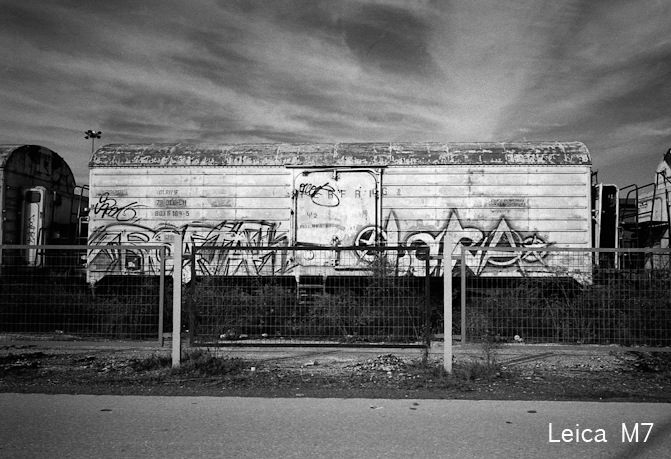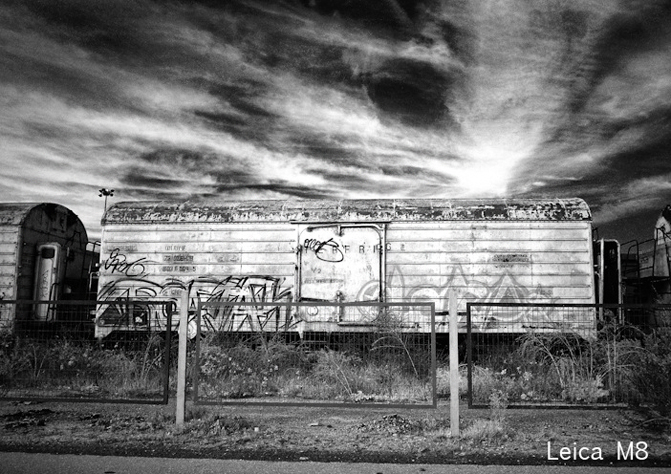A reader of this blog, Konstantinos Besios, sent in these two images in where he snapped the same scene with his M8 with a B+W 092 Infrared filter and his Leica M7 with Tri-X 400 and a B+W 091 Red Filter. The M7 was scanned on an Epson V500 scanner so it is not even close to the full potential fo film, but I am digging those dramatic tones of the M8 shot with the filter. These are really a “just for fun” post as teh images are too small to really appreciate but at least we can get an idea of what an M8 with the filter is capable of 🙂
Thanks for the images Konstantinos!
[ad#Adsense Blog Sq Embed Image]





You should have posted them without saying which was which… I bet many would guess wrong.
Trying to make a completely non-dramatic scene look dramatic usually ends with dramatic over-processing. Sorry, but I don’t care for the digital version at all.
+1. The IR/deep red filter phase I passed through very quickly, a long time ago. It got boring after a while, looked gimmicky to me. But that’s probably just me 😉
@Richard: the big differences I’ve seen between a flatbed scanner like theV500 and a Coolscan is when I print my photos (especially at large sizes). On the web of course, these differences are not so easy to see.
I enjoy using the IR “feature” of my m8. It has an excellent look. Here is one of my favorites.
[img]http://farm3.static.flickr.com/2767/4265283028_41ac91329e_z.jpg[/img]
NICE!!! – So M8 is IR digital film 🙂
Film, of course.
Yogi
Film 100% !
Greg
I’m going to have to retract my ‘what was the point’ post. Approaching the images from the point of view of IR vs non-IR, I took a second and third look at both images and had a hard time deciding which I like better. The lighter foreground below the trailer works better in the M8 IR image, but the higher contrast of grafitti on the trailer and between the trailer and the sky works better in the M7 film image. The M8 IR image is definitely more dramatic, perhaps a bit too much. The M7 film image looks more natural, but doesn’t make as strong a statement. Now I’m really wondering what the M8 without filter would look like–would the M8’s built-in IR sensitivity make a difference, or would it look just like the Tri-X image? Or perhaps a dark-red filter on the M8 would let in more visible spectrum light, and might make an image somewhere between the two you’ve taken.
Anyway, keep shooting!
@ Richard. I have a Coolscan 5000 ED and have had good results using the factory default settings. Reading what you are saying makes me think I am missing out! You would not know any link to scanning tips with the 5000 and specific film types etc?
Thanks!
Is there anything in my shots http://flickr.com/sinoperture that look markedly different to your scans?
Hi Richard, at first glance they look pretty similar but will have to have a closer look. Thanks for the link to your shots. Really like them a lot.
@Richard Ford: I shot this roll at ISO 320, although I usually shoot Tri-X at iso 400. Scanning is indeed a craft that takes a lot to master.
@Peter Komar: I totally agree, that’s why I still shoot b&w film (and probably will as long as film is available!)
@Garry: you are right , I’ve shot a couple of Ilford SFX200 handheld on sunny days, no problem at all (of course the SFX is not a true it film, I’ve just received a few rolls of Efke IR820, will give them a try soon).
@Jeremy: of course it’s not a true comparison, just happened to have both cameras with me that day and I thought it would be nice to share. Although I shoot a lot with the 092 filter and the M8, I haven’t tried taking the same picture with & without the filter, that’s a good idea and will try it as soon as possible, thank you.
@Steve: thank you for the post .
It goes without saying that I prefer the film image 🙂
Not that the M8 is bad but in a darkroom, that negative can be made to look like a million bucks. A lith print for example, on Slavich Unibrom or Fomatone MG Classic, souped in LD20 or Moersch, would be amazing. A little selenium or gold toning, on 16×20 paper, and that M8 image is a non issue 🙂
I think I like the M8 image better although its slightly over-processed. It just have more punch.
I much prefer the film version, looks real to me rather than over processed and over the top HDR? I just can’t make a connection to digital B&W these days. I wish the camera manufacturers would produce a 35mm B&W digital camera for the photographers that long for realistic looking output in B&W. I have since gone back to film for B&W and have no regrets. Please go back into your portfolios and look at your old B&W prints and compare to what digital B&W produces today, for me a huge difference.
I guess I am used to my CoolScan 5000 and it has taken me about 2 years to get very proficient at good scanning for the different films that I use given different exposures and developments.
So yeah – just a bit of fun! 😉
Did you shoot the TRI-X at box speed?
Wow, that came up a bit large!
Here is the link:
http://www.leicaimages.com/showphoto.php?photoid=9349&showall=1
Both are really good. The M8 is really dramatic and that is nice! Would choose the M7 though if push came to pull 😉
Here is one (I hope this will come up) from this weekend in Paris. Tri-X, M7 and CV Ultron 28mm.
[img]http://www.leicaimages.com/gallery/1242/U1242I1290557499.SEQ.0.jpg[/img]
Probably just about prefer the IR shot, but I like IR in general. You can shoot IR handheld on film too, if you’ve got enough light. Shooting Rollei IR 400 with an R72 filter, you’re looking at an effective ISO of 12 – 25. On a sunny day, that can be hand held easy enough. With the nature of infra red, you probably wouldn’t want to shoot it on a dull day anyway.
Both nice shots, BTW.
The developer used for Tri-X was Ilford DD-X (1:4), I usually develop it at 20 Celcius (68F) for 8 minutes. As Steve already mentioned this is not a scientific comparison of course. The film image is also my favorite (despite the fact that it’s less dramatic), I personally love the b&w tones of film and the M with Tri-X is a wonderful combination, especially for street photography. A dedicated film scanner like the Coolscan would provide even better results. On the other hand, the fact the the M8 can be shot handheld with an infrared filter is really a joy since infrared images have a unique look and can transform an everyday scenery to something really special.
Thanks for sharing. A coolscan is on my wish list too
The M8 has rendered the sky nicely, yes, but check out the detail on the boxcar & foreground with the M7!! And as Steve mentioned, it could more than likely be scanned much better.
LFI magazine did a really cool article in their last issue of the M8 and shooting B&W with no filter. It was pretty cool and worth reading if you can get your hands on it. There is something to be said for the IR light which we can’t see with the naked eye.
The M8 has an infrared filter on it. It is hard to compare that to an M7 with a dark red filter on it. They are not really comparable. I think we should just be enjoying each image and not trying to make any judgments on the cameras used.
I wonder what chemical and delution the tri-x has been processed in?
This is an odd comparison. The M8 with 092 Infrared filter is going to be WAY different than Trix-X with an 091 Red filter. The M8 is notoriously sensitive to infrared, so much so that you need to use a special IR-blocking filter to avoid weird colors in some cases. Tri-X, on the other hand, has no sensitivity to infrared. To get the M7 to produce a photo anything like the M8 w/092 filter, you’d need to use infrared film (and a 092 filter).
Not to be rude, but what is the point? The only thing that you can determine from this comparison is that an infrared photo looks different than a visible spectrum photo. I guess you could conclude that infrared photography is much more convenient with the M8, but that’s pretty obvious–you don’t need to look at comparison photos to come up with that conclusion. The M8 with and without 092 filter would’ve been more interesting imho.
Looks almost HDR-like, that second one, don’t like it…
I like the images, but feel that the second one is over processed or contrasty? Then again, it’s more dramatic. I still love B&W film better.
Actually the M* images is an Infrared image. The 092 allows in light primarily only in the IR frequencies (740nm or so). This really isn’t a true apple to apple comparison. If the M7 was loaded with say Efke IR 820c (or old HIE) and shot with an IR filter, then the results would be nearly identical to the M8. The M8’s sensitivity to IR, while making it a bit of a pain when shooting in color, can be effectively exploited to shoot in IR. A bit longer exposure, and the plants (which are light grey in the M8 shots) would be white as well.
For once, I can honestly say I do not really care for the M8 image. Love my Tri-X which with the M7 provides a better tonal range IMO. The M8 is just too contrasty for my tastes. Go Tri-X!!!!